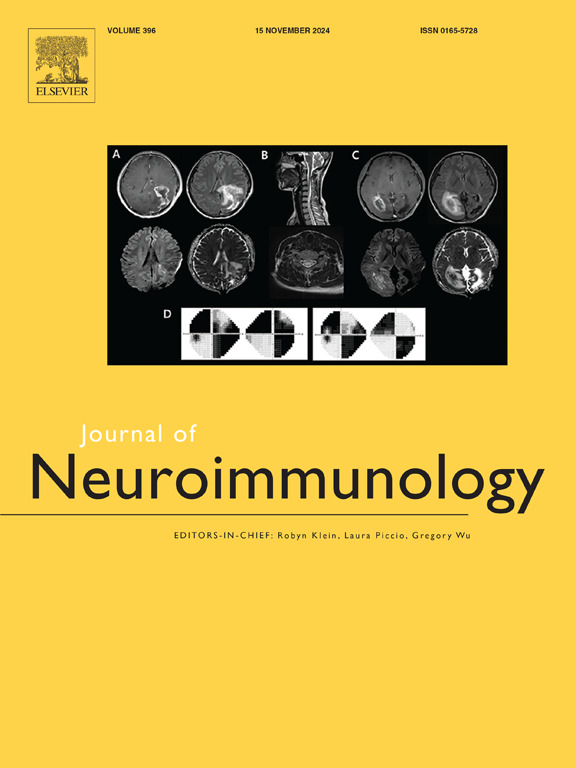小rna测序测定健康和多发性硬化症患者CD4+ T细胞亚群的MicroRNA特征
IF 2.9
4区 医学
Q3 IMMUNOLOGY
引用次数: 0
摘要
具有特殊功能的不同CD4+ T细胞亚群在免疫反应的不同阶段起作用。其中包括表型和功能特征naïve,中枢记忆(CM),效应记忆(EM)和调节性(Treg)细胞。利用小rna测序,我们分析了来自健康受试者和未经治疗的复发-缓解型多发性硬化症(RRMS)患者的这些细胞亚群中的mirna。MiRNA基因组聚类和丰度也进行了研究。从60个差异表达最多的mirna中,我们确定了naïve和处于稳态的记忆细胞的广泛和高度选择性的核心特征,而miR-146a-5p在Treg细胞中被强烈上调。与其他研究一样,我们鉴定了naïve细胞的5-miRNA核心(miR-125b-5p, miR-99a-5p, miR-365a-3p, miR-365b-3p, miR-193b-3p)。在记忆细胞中,EM细胞比CM细胞表达更多相同的mirna,支持渐进式T细胞分化模型。对于8-miRNA核心(来自miR-23a ~ 27a ~ 24-2, miR-23b ~ 27b ~ 24-1, miR-221 ~ 222集群,miR-22-3p, miR-181c-5p)和大ChrXq27.3 miR-506 ~ 514集群的成员尤其如此。有趣的是,据报道,这些mirna中的大多数对细胞增殖和存活具有负调控作用。最后,我们发现naïve和记忆CD4+ T细胞的miRNA核心特征在RRMS患者中是保守的。只有少数mirna被定量修饰,其中miR-1248在EM细胞中被证实下调。总的来说,这项研究扩展并提供了对CD4+ T细胞亚群的miRNA谱分析的新见解,这可能对进一步的研究有用。本文章由计算机程序翻译,如有差异,请以英文原文为准。

MicroRNA signatures of CD4+ T cell subsets in healthy and multiple sclerosis subjects determined by small RNA-sequencing
Diverse CD4+ T cell subsets with specialized functions operate at different phases of the immune response. Among these are phenotypically and functionally characterized naïve, central memory (CM), effector memory (EM), and regulatory (Treg) cells. Using small RNA-sequencing, we have profiled miRNAs in these cell subsets from healthy subjects and untreated patients with relapsing-remitting multiple sclerosis (RRMS). MiRNA genomic clustering and abundance were also investigated. From the 60 most differentially expressed miRNAs, broad and highly selective core signatures were determined for naïve and memory cells at homeostasis, while miR-146a-5p was strongly upregulated in Treg cells. In line with other studies, a 5-miRNA core was identified for naïve cells (miR-125b-5p, miR-99a-5p, miR-365a-3p, miR-365b-3p, miR-193b-3p). In memory cells, a number of identical miRNAs were more expressed in EM than CM cells, supporting the progressive T cell differentiation model. This was particularly the case for an 8-miRNA core (members from miR-23a∼27a∼24–2, miR-23b∼27b∼24–1, miR-221∼222 clusters, miR-22-3p, miR-181c-5p) and for the large ChrXq27.3 miR-506∼514 cluster. Interestingly, most of these miRNAs were reported to negatively regulate cell proliferation and survival. Finally, we found that the miRNA core signatures of naïve and memory CD4+ T cells were conserved in RRMS patients. Only few miRNAs were quantitatively modified and, among these, miR-1248 was validated to be downregulated in EM cells. Overall, this study expands and provides novel insights into miRNA profiling of CD4+ T cell subsets that may be useful for further investigations.
求助全文
通过发布文献求助,成功后即可免费获取论文全文。
去求助
来源期刊

Journal of neuroimmunology
医学-免疫学
CiteScore
6.10
自引率
3.00%
发文量
154
审稿时长
37 days
期刊介绍:
The Journal of Neuroimmunology affords a forum for the publication of works applying immunologic methodology to the furtherance of the neurological sciences. Studies on all branches of the neurosciences, particularly fundamental and applied neurobiology, neurology, neuropathology, neurochemistry, neurovirology, neuroendocrinology, neuromuscular research, neuropharmacology and psychology, which involve either immunologic methodology (e.g. immunocytochemistry) or fundamental immunology (e.g. antibody and lymphocyte assays), are considered for publication.
 求助内容:
求助内容: 应助结果提醒方式:
应助结果提醒方式:


